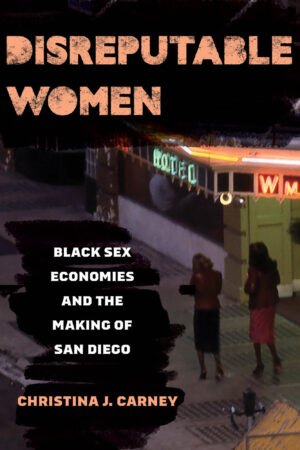The Militarization of Interracial Solidarity
By Christina Jessica Carney, author of Disreputable Women Black Sex Economies and the Making of San Diego
“I’m living in a war zone.” That’s what my mother said to me after ICE, the FBI and a US Border Patrol Black Hawk helicopter descended upon and raided an apartment building on 75th & Southshore Drive in Chicago on September 30, 2025 - only two blocks away from my mother’s apartment. Allegedly, authorities were looking for a Venezuelan gang, but the raid resulted in mostly African-American residents (including children) reportedly being zip-tied, put in the back of U-Haul vehicles, and detained for hours without justification. In disbelief and horror, my mom called her landlord asking them if their building would be targeted next. Living almost 400 miles from her in Missouri, I felt absolutely helpless.
Much has been written about Ice’s Southshore raid, yet Vic Mensa’s op-ed in the New York Times, “Trump Is Pitting Us Against One Another in Chicago,” caught my attention because it was written by a fellow Chicagoan and it accurately reflected local racial tensions between Venezuelans/Latinx and African-Americans in the Southshore neighborhood. While one man expressed “love for his new Venezuelan neighbors,” another said ''I don't agree with how they did it [the raid], but they needed to get them out.'' Unfortunately, this us/them binary is even reflected in Mena’s own thoughts: “Much of the responsibility of providing for the Venezuelans ended up being shouldered by Chicago's Black community…” or “Just as Mr. Abbott had hoped, many Chicagoans wondered why the migrants' plight had to be our problem to solve.”
I see Mena’s NYT op-ed as a missed opportunity. This could have been a moment to talk about how our political movements (regardless if they center race, sexuality, gender, or other categories of difference) are strengthened by interracial solidarity. Although messy, it is also a space where assumptions about certain racial groups could be discussed, challenged, and dispelled so that we can get to the real issue - combatting global white supremacy, in all of its iterations. Instead, Mena bolsters anti-immigrant rhetoric by claiming that our Latinx neighbors are a burden and that “services were diverted away from our most vulnerable.” It is unclear exactly what services Venezuelans are taking away from Black Chicagoans. Numerous studies show that immigrants, including Latinx communities, contribute more in taxes and labor than they consume in public benefits. In fact, many immigrants cannot access most federal benefits due to legal restrictions, meaning they often pay into systems they cannot fully use. Vulnerability among citizens (e.g., housing insecurity, healthcare gaps) is primarily driven by systemic underfunding, wage stagnation, and policy failures, not by immigrant communities. Framing our Venezuelan and other Latinx neighbors as burdens undermines solidarity among marginalized groups who share common struggles against poverty and inequality. Despite the promising title of Mena’s NYT op-ed, he falls into a familiar but effective trap.

Interracial solidarity and collectivity are some of the themes I tackle in my book, Disreputable Women: Black Sex Economies and the Making of San Diego. Before I wrote this book, I framed race relations in a way that aligned with the sentiments of Mena. Being from Chicago, I also framed race as black and white - many times completely ignoring the experiences of Latinx Chicagoans. The spatial geography of Chicago, considered by some as the most historically segregated city in the US, makes it very easy to see these divisions as natural and common sense. Yet, what I discovered from my work in San Diego is how the state, especially the US War Department, used space to create divisions between communities of color. In fact, my case study of San Diego demonstrates how social spaces in turn-of-century San Diego were very interracial, with Black, Chinese, Indigenous, Japanese and Mexican folx often socializing and laboring together, side-by-side. However, this interracial intermingling created a moral crisis where military and municipal authorities systemically disrupted this sociality by creating rigid racial taxonomies and instituting miscegenation as a crime - often under the guise of protecting white servicemen from “disreputable negro women,” for example. In other words, authorities intentionally and strategically disrupted class solidarity and consciousness, which conveniently benefitted state interests; the pitting of black, white, immigrant laborers against each other was a way to distract workers from the conditions under which they labored.
Even though Chicago was already developing much stronger patterns of racial segregation in the late 19th century, there are some similar threads between the two cities. The Levee District (Near South Side) and Stingaree (downtown San Diego) were controlled and organized by police; while racially segregated (white) institutions were often left unmolested, working-class/interracial institutions were raided by authorities for disobeying local miscegenation laws. Yet these areas (and other places nearby) provided the only affordable housing for newly arrived migrants of all races - like the Union Stock Yards of Chicago and the current location of Petco Park in San Diego. The boarding/rooming houses in these areas often housed racially diverse lodgers. Yet, as history shows us, these spaces were often short-lived.
The Southshore raid and its aftermath remind us that racialized narratives of scarcity and competition are not new—they are deeply rooted in state strategies that fracture solidarity among marginalized communities. When we accept the framing of immigrants as burdens, we reinforce the very systems that perpetuate inequality for all of us. History teaches that interracial solidarity has always been possible—and powerful—when communities resist these divisive tactics. If we are serious about dismantling global white supremacy and building a more just society, we must reject zero-sum thinking and embrace solidarity as both a political practice and a moral imperative. Our liberation is intertwined; the question is whether we will recognize it in time.